Susan C. Ingram | Special to JT
“On this one little small street in Baltimore, you have two of the oldest synagogue buildings still standing in the country. And one of them still has services,” says local historian Fred Shoken. “It’s pretty unique.”
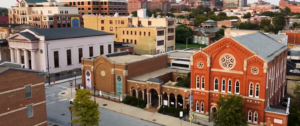
Early on in the documentary “Synagogue Stories: A Tradition of Change on Lloyd Street,” Shoken sums up with these words what makes Lloyd Street not only a local treasure, but a national one as well. Stretching south from Baltimore Street, it is home to the massive, Greek revival-style Lloyd Street Synagogue, built in 1845, and the Moorish architecture-inspired B’nai Israel Synagogue, built in 1876. In between the two, with its Herbert Bearman Campus connecting and encompassing both historic synagogues, is the Jewish Museum of Maryland. In fact, the museum has its roots in the Jewish Historical Society of Maryland, which formed in the early 1960s amid efforts to preserve the Lloyd Street Synagogue.
An overarching theme of this film, the culmination of a two-year project of the JMM, is that while these two synagogues inhabit space just a block apart, they have two very different histories.
“Lloyd street synagogue has changed many times, because it changed from being a traditional synagogue to being a Reform synagogue, to being a church to being a traditional synagogue and now it’s a museum,” says museum docent Karen Rubin in the film.
B’nai Israel, on the other hand, says Erika Reif Hornstein — JMM board member, B’nai Israel member, and descendent of one of B’nai Israel’s early presidents — represents continuity. “Since 1876, there has always been a Jewish congregation practicing here,” she says.
JMM archivist and “Synagogue Stories” project lead Maggie Hoffman says the job of the museum is to synthesize those two disparate stories. “Caring for the Lloyd Street and B’nai Israel synagogues and cultivating connections to those spaces is a core part of the museum’s mission,” she says.
The film traces not just the histories of the two synagogues, but of the growth of Jewish Baltimore, especially in the area known as Jonestown: east of the Jones Falls, where Lloyd Street and its intersection with Lombard Street was once a commercial hub for Jewish and other immigrant communities.
“This film explores the history of the Lloyd Street and B’nai Israel Synagogues, but it does so much more than that,” said museum executive director Sol Davis in an interview with the JT. “At the Jewish Museum of Maryland, we’re committed to imagining Jewish futures. What do we want our community to look like ten years from now? Fifty years from now?”
“That work requires thoughtful consideration of our present experiences,” he continued. “Exploring the stories of these synagogues and the communities that grew in and around them can help fill in the picture of Jewish life in Baltimore today. We see value in drawing these connections between the past and present as a practice that can help move us forward together.”
Living history
Baltimore Hebrew Congregation built the Lloyd Street Synagogue, designed by architect Robert Cary Long, Jr., and used it as their house of worship until 1889. From that point until 1905, it served a different immigrant community — as St. John the Baptist Lithuanian Catholic Church. When they in turn put it up for sale, Jewish congregation Shomrei Mishmeres Ha-Kodesh returned the building to its original purpose for nearly the next 60 years.
Only two synagogues in the country — Touro Synagogue in Newport, Rhode Island, founded in 1763, and Kahal Kadosh Beth Elohim in Charleston, South Carolina, founded in 1841 — are older than the Lloyd Street Synagogue. It is the oldest synagogue in Maryland.
Down the street, B’nai Israel Synagogue was first home to Chizuk Amuno Congregation, a breakaway group from Baltimore Hebrew Congregation. In 1895, Chizuk Amuno sold the building to B’nai Israel when they, like Baltimore Hebrew before them, relocated to Northwest Baltimore.
But just telling the long and linked history of the two extraordinary institutions wasn’t the only impetus when the JMM began seeking a filmmaker to tell this special story.
While the two synagogues have been renovated and updated repeatedly over their lifetimes, neither historic building is completely accessible for people with mobility challenges. As such, one of the first goals of the documentary was to create a comprehensive visual and aural historical experience for those who can’t physically navigate the old structures.
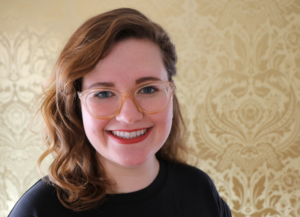
“We regularly offer tours of these nationally significant buildings to museum visitors and school groups, but the buildings are not currently accessible to individuals with mobility devices,” said Hoffman. “We wanted to create a film that would share the stories these spaces can tell us about Jewish life in Baltimore. Making the film accessible by integrating captions and audio description was also a priority from day one.”
Making the JMM campus accessible to wider audiences was supported by The Maryland Heritage Areas Authority and the Herbert Bearman Foundation, Hoffman added.
Rich Polt of Baltimore’s Acknowledge Media was selected by the museum to produce the project. Polt and a small crew, including cinematographer Richard Chisolm and drone operator Jerry Jackson, lovingly lit and composed interiors and exteriors and interviews with museum docents, historians, and museum staff over just two days last September. Editing and post-production took another eight months to complete the ultimately 36-minute film, which is set to premiere at a special event for museum members this Sunday.
“It was deeply gratifying to participate in this project,” Polt said. “I already knew a fair amount about these two synagogues, but I didn’t really fully appreciate how they played into the larger arc and narrative of Judaism and the Jewish people in this city. To tell this story, we had to go all the way back to the very beginning. You have to understand what it’s like to be Jewish in Baltimore, in the early 1800s, to understand why there are no synagogues at that point in time.”
For cinematographer Chisolm, it was important to tell those stories through the background and lighting of the subjects, as well as the interviews.
“We had to find suitable places that were quiet and visually interesting in the background, so that every background has a reason for being,” said Chisolm. “There are little subtle, out-of-focus details — it might be a menorah, it might be the bima, it might be the architecture of the pews. Every background we chose, we wanted to be meaningful to the context of who the people were and what they were talking about.”
Davis and museum staff hope the film spurs dialogue about Jewish experiences in Baltimore.
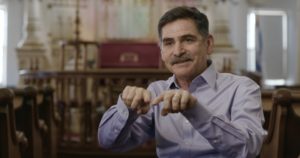
“One of the priorities in creating this film was to bring in an array of voices to tell these stories. We’re leaning away from recounting history from a single, authoritative source. Instead, we’re intentionally bringing people together to share history collectively,” he said.
“These two synagogues carry so much meaning to people and there are varied perspectives on their history. We’re thrilled to share the stories we gathered about these spaces, and we recognize that visitors will have thoughts to share. We hope that our audiences consider the viewing experience both as an opportunity to learn a little more about these two synagogues and a chance to build connections and engage in conversation about the rich legacy of these spaces.”
Rediscovering artifacts
For Davis and Hoffman, this project offered an opportunity to revisit documents and artifacts in the museum’s collections related to the history of each synagogue.
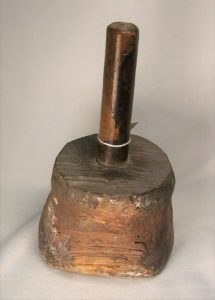
“We’ve shared many of these gems in recent exhibits, but looking at the collection as a whole was a rewarding experience,” Hoffman told the JT. “One object in the film that hasn’t gotten much attention in the past is Henry Berge’s hammer. Berge was the architect of B’nai Israel, and we’re privileged to hold a mallet he used in his work. This film was a chance to highlight some of our objects that community members may not be familiar with yet.”
Throughout the film, former director of collections and exhibits Joanna Church offers vignettes of important artifacts from the synagogues, including a woman congregant’s prayer book, a 1904 tefillin bag, an ark curtain, a five-branch menorah and a spittoon.
These artifacts enlighten the histories of the synagogues and the communities that supported them, as does the film as a whole, enhancing the museum tours, which Hoffman said is one of many reasons why people should come out to see the film.
“This film approaches these historic synagogues differently than our docent-led tours do,” she said. “We’re proud to share the history of these spaces and the congregations that grew out of them. It’s important to us that we continue to raise these stories and share them with Maryland’s Jewish community. After all, so many congregations in the area can trace their roots back to these spaces.”
Jewish Museum of Maryland members are invited to the premiere screening of “Synagogue Stories: A Tradition of Change on Lloyd Street” on Sunday, Sept. 18. Doors open at 10 a.m. and the screening will begin at 11 a.m. The screening will be followed by an interactive Q&A with the team behind the film. Event registration is required, and capacity limited. The video will be available for on-site museum visitors in a viewing station at the museum beginning in November. For more information, including details on future screenings, contact [email protected].
Susan C. Ingram is a freelance writer.



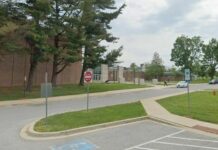
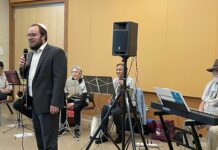
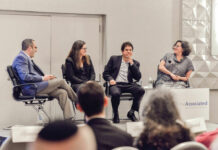


What exhibit is leaving the beginning of October? I don’t want to miss it.